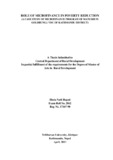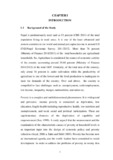Please use this identifier to cite or link to this item:
https://elibrary.tucl.edu.np/handle/123456789/2268Full metadata record
| DC Field | Value | Language |
|---|---|---|
| dc.contributor.author | Regmi, Bholanath | |
| dc.date.accessioned | 2021-04-21T09:58:49Z | |
| dc.date.accessioned | 2021-07-23T04:06:46Z | - |
| dc.date.available | 2021-04-21T09:58:49Z | |
| dc.date.available | 2021-07-23T04:06:46Z | - |
| dc.date.issued | 2019 | |
| dc.identifier.uri | http://elibrary.tucl.edu.np/handle/123456789/2268 | - |
| dc.description.abstract | One of the common solutions to resolve poverty, a big issue in both Nepal and in the World, is national programs that have given small credit for the poor. However, financial services alone cannot improve poverty effectively because poverty can be caused by multiple reasons. Microfinance (MF) intervention for poor women is considered as an appropriate way to attack poverty. The impact of Microfinance Institution (MFI) on livelihoods of poor women households through accumulation of social, human, financial, natural, and physical assets that contributes to poverty reduction needs to be examined. In recent decades, microfinance – small-scale financial services to low-income households – has given the promise of improving the lives of hundreds of millions of people across the world. The literature on microfinance identifies outreach, impact, and sustainability as the three goals of microfinance institutions. This thesis focuses on qualitative and quantitative impact of microfinance program on participating women of Goldhunga Village Development Committee of Kathmandu district. The main objective of the study is to make an assessment of the effectiveness of microfinance program and to analyze the effect of Microfinance in living standard and empowerment of women participants in the study area in Goldunga VDC of Kathmandu District. The research was conducted in Sixty members of Manushi, a financial intermediary non government organization registered under district administrative office of Nepal government. It has been operating Microfinance program in the study area. It was done through filling up detailed questionnaire through personal interview with members of microfinance program. The study shows that above 95 percent respondents send | en_US |
| dc.language.iso | en_US | en_US |
| dc.publisher | Central Department of Rural Development | en_US |
| dc.subject | Role | en_US |
| dc.subject | Poverty | en_US |
| dc.subject | Reduction | en_US |
| dc.title | Role of Microfinance in Poverty Reduction (A Case Study of Microfinance Program of Manushi In Goldhunga VDC of Kathmandu District) | en_US |
| dc.type | Thesis | en_US |
| Appears in Collections: | Rural Development | |
Files in This Item:
| File | Description | Size | Format | |
|---|---|---|---|---|
| Cover Page(5).pdf | 28.3 kB | Adobe PDF |  View/Open | |
| Chapter I.pdf | 266.4 kB | Adobe PDF |  View/Open |
Items in DSpace are protected by copyright, with all rights reserved, unless otherwise indicated.
